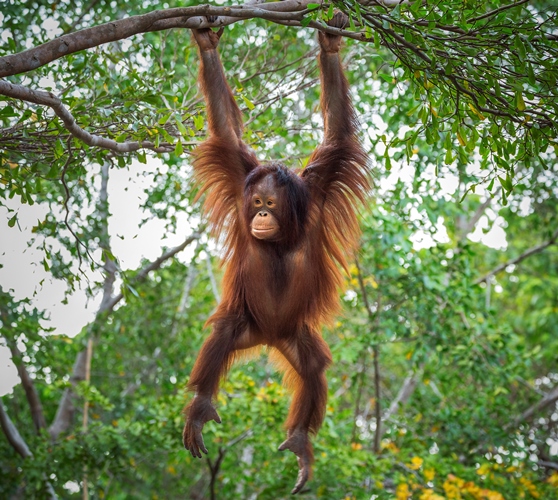Conservationists have determined that the Bornean orangutan (Pongo pygmaeus) is disappearing much more rapidly than previously thought. Since 1999, the total number of Bornean orangutans declined by at least 148,000 individuals. The chief culprits for this sharp drop in population size are deforestation and hunting by humans, which together are threatening the existence of this species of ape. In fact, the substantial population reduction is greater than the actual number of Bornean orangutans presently inhabiting the island of Borneo. The current population is estimated to consist of 70,000 to 100,000 individuals, and further reductions of 50–66% are projected to occur by the year 2050 if appropriate measures are not taken to preserve and protect this animal from extinction. See also: Apes; Conservation (species); Deforestation; Endangered species; Extinction; Population ecology; Population viability; Primates

Orangutans are confined to the tropical rainforests of Borneo and Sumatra. The Bornean orangutan is found on Borneo, whereas the other two species of orangutans—the Sumatran orangutan (Pongo abelii) and the Tapanuli orangutan (Pongo tapanuliensis)—inhabit Sumatra. All three species are critically endangered. However, as a result of dozens of field surveys (utilizing aerial and ground methodologies) that have been undertaken on Borneo since 1999, the population viability of the Bornean orangutan is being threatened more seriously than scientists estimated. See also: Biogeography; Island biogeography; New orangutan species; Rainforest
The areas inhabited by the Bornean orangutan require swift conservation measures. Deforestation rates in Borneo are extremely high, with an average of 35,000 hectares (86,500 acres) being lost annually since 2001. Palm oil and paper pulp companies are responsible for most of the conversion of pristine Bornean forests into plantations, eliminating the natural habitats of the Bornean orangutans. Moreover, humans are hunting and killing these apes in large numbers, affecting the long-term viability of this species. In particular, because orangutans have a very long reproductive cycle, with one baby being born per adult female every 6 to 8 years, they are very sensitive to population reductions that result from killings. Therefore, without a dramatic halt to these deforestation and hunting activities, researchers fear that future Bornean orangutan populations will not be able to survive in the wild. See also: Environmental management; Forestry; Land-use planning





